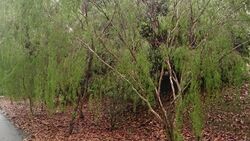Biology:Leptospermum madidum
| Leptospermum madidum | |
|---|---|

| |
| Scientific classification | |
| Kingdom: | Plantae |
| Clade: | Tracheophytes |
| Clade: | Angiosperms |
| Clade: | Eudicots |
| Clade: | Rosids |
| Order: | Myrtales |
| Family: | Myrtaceae |
| Genus: | Leptospermum |
| Species: | L. madidum
|
| Binomial name | |
| Leptospermum madidum A.R.Bean[1]
| |
| Synonyms[1] | |
| |
Leptospermum madidum is a species of shrub or small tree that is endemic to north-western Australia. It has weeping branches, smooth bark, pale green linear leaves, small white flowers and thin-walled fruit.
Description
Leptospermum madidum is a shrub or tree that typically grows to a height of 1.5–8 m (4 ft 11 in–26 ft 3 in) and has weeping branches and smooth white, cream-coloured or pink bark. The leaves are arranged alternately, sessile, linear, the same shade of pale green on both sides, 22–70 mm (0.87–2.76 in) long and 1–9 mm (0.039–0.354 in) long. The flower buds are arranged singly in leaf axils surrounded by bracts that are shed before the flower opens. The flowers are 5–7 mm (0.20–0.28 in) wide on a pedicel about 1 mm (0.039 in) long. The floral cup is 2–3 mm (0.079–0.118 in) long, and the sepals have hairy margins. Flowering occurs from July to October and the fruit is a glabrous capsule 2–3 mm (0.079–0.118 in) long and 2.5–5 mm (0.098–0.197 in) wide.[2][3][4]
Taxonomy and naming
This species was first formally described in 1920 by Cyril Tenison White and William Douglas Francis who gave it the name Agonis longifolia and published the description in the Botany Bulletin, Department of Agriculture, Queensland.[5] In 1958 Stanley Thatcher Blake changed the name to Leptospermum longifolium but the name was an illegitimate name because it had already been used for a different species.[6] 1992 by Anthony Bean changed the name to Leptospermum madidum, publishing the change in the journal Austrobaileya.[2][7] The specific epithet (madidum) is from a Latin word meaning "moist" or "wet", referring to the species' growing on the banks of freshwater creeks and rivers.[8]
In the same journal, Bean described two subspecies and their names are accepted by the Australian Plant Census:
- Leptospermum madidum A.R.Bean subsp. madidum[9] has leaves 4.5–9 mm (0.18–0.35 in) wide and fruits 3.5–5 mm (0.14–0.20 in) wide;
- Leptospermum madidum subsp. sativum A.R.Bean[10] has leaves 1–4.5 mm (0.039–0.177 in) wide and fruits 2–3.5 mm (0.079–0.138 in) wide.
Distribution and habitat
Subspecies madidum is confined to the Cape York Peninsula where it grows on the banks of creeks and rivers. Subspecies sativum is found along watercourses and in sandstone gullies in the Kimberley region of Western Australia and the northernmost parts of the Northern Territory.[2][3]
Conservation status
Leptospermum madidum is listed as "not threatened" by the Government of Western Australia Department of Biodiversity, Conservation and Attractions,[3] but subsp. sativum is classified as "Priority Three"[11] meaning that it is poorly known and known from only a few locations but is not under imminent threat.[12]
References
- ↑ 1.0 1.1 "Leptospermum madidum". https://biodiversity.org.au/nsl/services/apc-format/display/117983. Retrieved 20 April 2020.
- ↑ 2.0 2.1 2.2 Bean, Anthony R. (1992). "The Genus Leptospermum Forst. et Forst.f. (Myrtaceae) in northern Australia and Malesia". Austrobaileya 3 (4): 645–646.
- ↑ 3.0 3.1 3.2 "Leptospermum madidum". FloraBase. Western Australian Government Department of Parks and Wildlife. https://florabase.dpaw.wa.gov.au/browse/profile/13348.
- ↑ "Leptospermum madidum A.R.Bean". NT Flora. Northern Territory Government. 2013. http://eflora.nt.gov.au/factsheet?id=3886. Retrieved 20 March 2017.
- ↑ "Agonis longifolia". APNI. https://id.biodiversity.org.au/instance/apni/492845. Retrieved 20 April 2020.
- ↑ "Leptospermum longifolium". APNI. https://id.biodiversity.org.au/instance/apni/492846. Retrieved 20 April 2020.
- ↑ "Leptospermum madidum". APNI. https://id.biodiversity.org.au/instance/apni/552229. Retrieved 20 April 2020.
- ↑ Francis Aubie Sharr (2019). Western Australian Plant Names and their Meanings. Kardinya, Western Australia: Four Gables Press. p. 247. ISBN 9780958034180.
- ↑ "Leptospermum madidum subsp. madidum". https://biodiversity.org.au/nsl/services/apc-format/display/117984. Retrieved 20 April 2020.
- ↑ "Leptospermum madidum subsp. sativum". https://biodiversity.org.au/nsl/services/apc-format/display/117985. Retrieved 20 April 2020.
- ↑ "Leptospermum madidum subsp. sativum". FloraBase. Western Australian Government Department of Parks and Wildlife. https://florabase.dpaw.wa.gov.au/browse/profile/13347.
- ↑ "Conservation codes for Western Australian Flora and Fauna". Government of Western Australia Department of Parks and Wildlife. https://www.dpaw.wa.gov.au/images/documents/plants-animals/threatened-species/Listings/Conservation%20code%20definitions.pdf. Retrieved 19 June 2022.
Wikidata ☰ Q15368759 entry
 |


